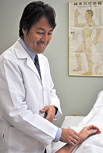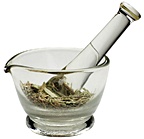
Not a subscriber?
Unsubscribe
Update e-mail address
September 2011 [Volume 10, Issue 9]
To Your Health is brought to you by:
In this issue of To Your Health:
By Sara Calabro, LAc
 A lot of acupuncturists were enthusiastic about the release of 9000 Needles, but perhaps none more than Atsuki Maeda. The documentary follows an American stroke victim to China, where he receives acupuncture from a team of doctors led by Shi Xue Min—Maeda's teacher. After completing acupuncture school in Japan, Maeda participated in an exchange program that sent recent graduates to China's renowned First Teaching Hospital of Tianjin University of Traditional Chinese Medicine. While there, he became one of the first students to get certified in Xing Nao Kai Qiao Fa (known as XNKQ), a form of stroke therapy developed by Dr. Shi. It has been Maeda's dream ever since to expand awareness and accessibility of this powerful treatment.
A lot of acupuncturists were enthusiastic about the release of 9000 Needles, but perhaps none more than Atsuki Maeda. The documentary follows an American stroke victim to China, where he receives acupuncture from a team of doctors led by Shi Xue Min—Maeda's teacher. After completing acupuncture school in Japan, Maeda participated in an exchange program that sent recent graduates to China's renowned First Teaching Hospital of Tianjin University of Traditional Chinese Medicine. While there, he became one of the first students to get certified in Xing Nao Kai Qiao Fa (known as XNKQ), a form of stroke therapy developed by Dr. Shi. It has been Maeda's dream ever since to expand awareness and accessibility of this powerful treatment.
9000 Needles has been a huge blessing in this regard — and has created much demand for XNKQ-trained acupuncturists in the U.S. In response, Emperor's College in Santa Monica, Calif., recently hired Maeda to lead its XNKQ stroke rehabilitation and prevention module, a new required component of the school's doctoral program. In June, Emperor's College launched the Stroke Rehabilitation & Dementia Care Center, where Maeda treats patients and leads clinical rounds for the students who will eventually join him as XNKQ-certified acupuncturists.
Herb of the Month – Licorice (gan cao)
 What is licorice? What is it used for?
What is licorice? What is it used for?
Licorice is a plant originally grown in central Europe, but now found all across Europe and Asia. Aside from its medicinal properties, it has been used to flavor foods for centuries. Licorice root is used medicinally.
The two most important components of licorice are glychrrhizin and flavonoids. Glycyrrhizin works as an anti-inflammatory and antiviral and inhibits the breakdown of cortisol. Licorice flavonoids are powerful antioxidants; they work to protect liver cells and help digestive tract cells heal. Test tube studies have found that licorice flavonoids kill heliobacter pylori, the bacteria responsible for most ulcers and stomach inflammation.
Today, licorice remains one of the most important herbs in traditional Chinese medicine. It addition to its use as a flavoring, licorice has traditionally been employed to sooth coughs and sore throats; coat the digestive and urinary tracts; and treat various conditions ranging from diabetes to tuberculosis.
Several studies have been conducted on deglycyrrhizinated licorice, or DGL. Studies have found that DGL tablets are effective in treating ulcers of the stomach and small intestine; one preliminary study found DGL can inhibit the growth and spread of canker sores. Other clinical studies have used licorice extracts to treat eczema and herpes.
How much licorice should I take?
For respiratory conditions, chronic fatigue syndrome and herpes, many herbalists recommend using "standard," or glycyrrhizinated, licorice. Licorice root capsules (5-6 grams per day) can be used, as can concentrated licorice extracts (250-500mg three times per day).
DGL is used for ulcers of the mouth, stomach and digestive tract. Most practitioners recommend one 200-300mg tablet three times per day before meals and before going to bed.
What forms of licorice are available?
Licorice root can be found at some health food stores and most Asian markets. Many health stores also sell standard and DGL licorice tablets, capsules and extracts.
What can happen if I take too much licorice? Are there any interactions I should be aware of? What precautions should I take?
Licorice products that contain glycyrrhizin may increase a person's blood pressure and cause water retention. Consumption of more than seven grams of licorice per day for more than seven days consecutively could increase blood testosterone levels. According to the German Commission E monographs, pregnant women or people with liver and/or kidney disorders should not use licorice.
Question about Migraines and Acupuncture: In the treatment of migraines with acupuncture, is the needle connected to anything? My sister in the UK had acupuncture, and the doctor burned something on the needle. I would like to be able to help my husband with his migraine headaches.
Answer: Yes, one acupuncture treatment can lessen or remove the pain of a migraine, and a series of treatments can lessen the frequency and severity of the headaches. Sometimes, for stronger stimulation to the point, for better effect, moxabustion or e-stim is used in conjunction with the acupuncture needles.
Unsubscribe
Thank you for subscribing to To Your Health. If you have received
this newsletter in error or wish to unsubscribe, you may remove your name
from our e-mail subscription list at www.acupuncturetoday.com/newsletter/TYH/unsubscribe.php.
Update your e-mail address
To update the e-mail address your newsletter is sent to, click here.
If you have any questions regarding your subscription, please complete this form at www.acupuncturetoday.com/newsletterhelp/TYH.
